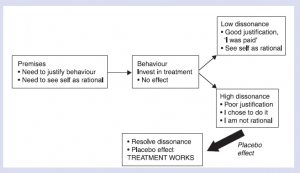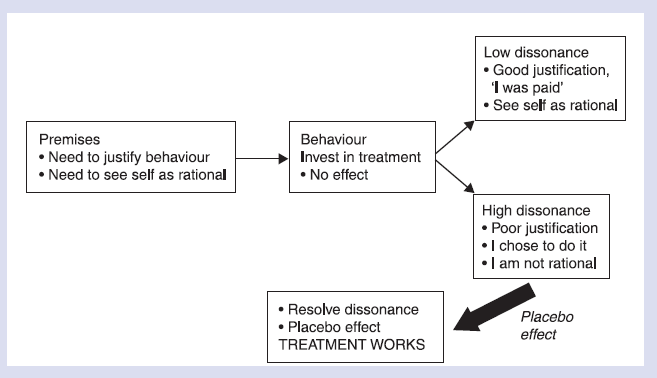Table of Contents
Cognitive Dissonance Theory
Totman (1976, 1987) placed his cognitive dissonance theory of placebos in the following context: ‘Why did faith healing last for such a long time?’ and ‘Why are many of the homeopathic medicines, which have no medically active content, still used?’ He argued that faith healing has lasted and homeopathic medicines are still used because they work.
In answer to his question of why this might be, Totman suggested that the one factor that all of these medically inert treatments have in common is that they required investment by the individual in terms of money, dedication, pain, time, or inconvenience. He argued that if medically inactive drugs were freely available they would not be effective and that if an individual lived around the corner to Lourdes then a trip to Lourdes would have no effect on their health status. (Cognitive Dissonance Theory)
(Cognitive Dissonance Theory)
The effect of investment
Totman suggested that this investment results in the individual having to go through two processes:
- The individual needs to justify their behavior;
- Individuals need to see themselves as rational and in control. If these two factors are in line with each other (e.g. ‘I spent money on treatment and it worked), then the individual experiences low dissonance.
If, however, there is a conflict between these two factors (e.g. ‘I spent money on treatment and I do not feel any better), the individual experiences a state of high dissonance. Totman argued that high justification (it worked) results in low guilt and low dissonance (e.g. ‘I can justify my behavior, I am rational and in control’). However, low justification (e.g. ‘it didn’t work’) results in high guilt and high dissonance (e.g. I cannot justify my behavior, I am not rational or in control). How does this relate to placebo effects and changes in symptoms?
Justification and changes in symptoms
If an individual travels far and pays a lot of money to see a faith healer then they need to justify this behavior. Also, they need to see themselves as being rational and in control. If they have put a lot of investment into seeing a faith healer and the faith healer has no effect on their health status, then they will not be able to see themselves as being rational and in control, and will, therefore, be in a state of high dissonance.
The best way to resolve this dissonance according to Totman is for there to be an outcome that enables the individual to be able to justify their behavior and to see themselves as rational and in control. In terms of a faith healer, the best outcome would be an improvement in health status. This would enable the individual to justify their behavior and to enable them to maintain a sense of self as one who is rational and sensible.
Totman argued that when in a state of high dissonance, unconscious regulating mechanisms are activated, which may cause physical changes that improve the health of the individual, which enables the individual to justify their behavior, and this resolves the dissonance. Totman, therefore, suggested that for a placebo effect to occur, the individual does not require an expectation that they will get better, but a need to find justification for their behavior and a state of cognitive dissonance to set this up. Totman’s model is illustrated in Figure 1.
 Figure 1. Totman’s cognitive dissonance theory of placebo effects (Cognitive Dissonance Theory)
Figure 1. Totman’s cognitive dissonance theory of placebo effects (Cognitive Dissonance Theory)
Evidence for the role of justification
Research has examined whether a need for justification does, in fact, relate to symptom perception. Zimbardo (1969) evaluated the effects of post hoc justification on hunger and thirst. Subjects were asked not to eat or drink for a length of time and were divided into two groups. Group one was offered money if they managed to abstain from eating and drinking, providing these subjects with a good justification for their behavior.
Group two was simply asked not to eat or drink for a length of time but were given no reason or no incentive, and therefore had no justification. Having good justification for their behavior, group one was not in a state of dissonance; they were able to justify not eating and still maintain a sense of being rational and in control. Group two had no justification for their behavior and were therefore in a state of high dissonance, as they were performing a behavior for very little reason.
Therefore in order to resolve this dissonance, it was argued that group two needed to find a justification for their behavior. At the end of the period of abstinence, all subjects were allowed to eat and drink as much as they wished. The results showed that group two (those in high dissonance) ate and drank less when free food was available to them than group one (those in low dissonance).
The results were interpreted as follows. The subjects in group two, being in a state of high dissonance, needed to find a justification for their behavior and justified their behavior by believing ‘I didn’t eat because I was not hungry. They therefore ate and drank less when food was available. The subjects in group one, being in a state of low dissonance, had no need to find a justification for their behavior as they had a good justification ‘I didn’t eat because I was paid not to’.
They, therefore, ate more when the food was offered. The results of this study have been used to suggest that high dissonance influenced the subject’s physiological state, and the physiological state changed in order to resolve the problem of dissonance.
Research has also examined the effects of justification on placebo-induced pain reduction. Totman (1987) induced pain in a group of subjects using heat stimulation. Subjects were then offered the choice of a drug in order to reduce pain. In fact, this drug was a placebo. Half of the subjects were offered money to take part in the study, and half were offered no money. (Cognitive Dissonance Theory)
Totman argued that because one group was offered an incentive to carry out the study and to experience the pain they had a high justification for their behavior, they, therefore, had high justification and were in a state of low dissonance. The other group, however, was offered no money and therefore had low justification for subjecting themselves to a painful situation; they, therefore, had low justification and were in a state of high dissonance.
Totman argued that this group needed to find some kind of justification to resolve this state of dissonance. If the drug worked, Totman argued that this would provide them with justification for subjecting themselves to the experiment and for choosing to take the drug. The results showed that the group in a state of high
dissonance experienced less pain following the placebo than the group in low dissonance.
Totman argued that this suggests that being in a state of low justification activated the individual’s unconscious regulating mechanisms, which caused physiological changes to reduce the pain, providing the group with justification for their behavior, which therefore eradicated their state of dissonance.
(Cognitive Dissonance Theory)
An example of Totman’s theory
The following example illustrates the relationship between justification, the need to see oneself as rational and in control, and the problem of dissonance between these two factors. (Cognitive Dissonance Theory)
Visiting Lourdes in order to improve one’s health status involves a degree of investment in that behavior in terms of time, money, etc. If the visit to Lourdes has no effect, then the behavior begins to appear irrational and unjustified. If the individual can provide justification for their behavior, for example ‘I was paid to go to Lourdes’, then they will experience low dissonance. (Cognitive Dissonance Theory)
If, however, the individual can find no justification for their visit to Lourdes and therefore believes ‘I chose to do it and it didn’t work’, they remain in a state of high dissonance. Dissonance is an uncomfortable state to be in and the individual is motivated to remove this state. Changing the outcome (e.g. ‘I feel better following my visit to Lourdes’) removes this dissonance and the individual can believe, ‘I chose to do it and it worked’. Therefore, according to cognitive dissonance theory, dissonance can be resolved by the placebo having an effect on the individual’s health status by activating unconscious regulating mechanisms.
Support for cognitive dissonance theory
The following factors provide support and evidence for cognitive dissonance theory:0
- The theory can explain all placebo effects, not just pain.
- The theory does not require patient expectations, but a choice. This helps to explain those reported instances where the individual does not appear to expect to get better.
- The theory suggests that the individual needs commitment to the medical procedure, which explains why the individual may need to show some investment (e.g. pain, time, money) in order to get better. This can explain some of the proposed effects of treatment characteristics, individual characteristics and therapist characteristics.
Problems with cognitive dissonance theory
However, there are several problems with cognitive dissonance theory:
- Much of the research examining the effects of justification has involved giving money to subjects to enable them to provide justification for their behavior. It is possible that providing subjects with money increases their anxiety and therefore increases pain perception.
- It is also possible that the experimenter’s attempt to persuade the individual to participate, itself also increases anxiety.
- Cognitive dissonance theory has mainly been tested using acute pain, which has been elicited in a laboratory setting. Whether the results are transferable to ‘real-life’ is questionable.
- Totman argues that patient expectations are not necessary. However, an individual must expect some changes following the intervention, otherwise, they would not make the original investment. It is also possible that paying subjects to participate changes their expectations of a successful outcome.
- Totman does not explain what these unconscious regulating mechanisms may be.
(Cognitive Dissonance Theory Image Source)
This post contains the content of book Health Psychology – a Textbook below is a link of a complete book Health Psychology – a Textbook
